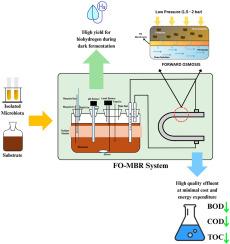用正向渗透膜生物反应器可持续利用废糖蜜制氢
IF 8.3
2区 工程技术
Q1 CHEMISTRY, PHYSICAL
引用次数: 0
摘要
本研究评估了正渗透膜生物反应器(FO-MBR)暗发酵的可行性,旨在同时生产生物氢和处理废水。通过对活性污泥进行热处理,使严格感梭菌1富集,H2产量达到2.21 mol,达到最佳接种效果。(mol己糖)−1(批量)。在连续操作条件下,底物浓度为4.4 g L−1,水力停留时间为12 h时效果最佳,H2产量为1.51 mol。(摩尔hexosesupplied)−1。FO-MBR配置1.1 m2中空纤维侧流膜模块,根据膜通量在动态HRT (2.5-12 h)下运行,并与间歇式连续搅拌槽式反应器(CSTR)操作集成,以对抗代谢物积累。该系统优于传统的CSTR,实现了1.78 mol H2的产氢率。(摩尔hexosesupplied)−1。处理效果显著,BOD5、COD和TOC去除率分别为95.32%、99.02%和99.10%,总垃圾量减少83.8%。此外,FO-MBR表现出很强的防污性能,在连续47.5小时的高强度肉汤浸泡后,经过5分钟的水力冲洗,水通量回收率达到96.14%。这些结果突出了FO-MBR系统作为综合制氢和污水处理的可持续和高性能替代方案的能力。进一步的研究建议解决长期污染控制和代谢物管理的工业可扩展性。本文章由计算机程序翻译,如有差异,请以英文原文为准。

Forward osmosis membrane bioreactor for sustainable hydrogen production from waste molasses
The current study evaluates the feasibility of a forward osmosis membrane bioreactor (FO-MBR) for dark fermentation, aiming at simultaneous biohydrogen production and wastewater treatment. Optimal microbial inoculation was achieved via heat-treated activated sludge, enriching Clostridium sensu stricto 1 and yielding up to 2.21 mol H2.(mol hexose)−1 in batch mode. In continuous operation, a substrate concentration of 4.4 g L−1 and a hydraulic retention time (HRT) of 12 h delivered the best results, producing 1.51 mol H2.(mol hexosesupplied)−1. The FO-MBR, configured with a 1.1 m2 hollow fiber side-stream membrane module and operated under dynamic HRT (2.5–12 h) dependent on membrane flux, was integrated with intermittent CSTR (Continuous stirred tank reactor) operation to counter metabolite accumulation. This system outperformed a conventional CSTR, achieving a hydrogen yield of 1.78 mol H2.(mol hexosesupplied)−1. Remarkable treatment efficiencies were observed with BOD5, COD, and TOC removal rates of 95.32 %, 99.02 %, and 99.10 %, respectively, and an 83.8 % reduction in total waste volume. Additionally, the FO-MBR demonstrated strong antifouling performance, with 96.14 % water flux recovery achieved after a brief 5 min hydraulic rinse following 47.5 h of continuous high-strength broth exposure. These results highlight the FO-MBR system's ability as a sustainable and high-performance alternative for integrated hydrogen production and effluent treatment. Further studies are recommended to address long-term fouling control and metabolite management for industrial scalability.
求助全文
通过发布文献求助,成功后即可免费获取论文全文。
去求助
来源期刊

International Journal of Hydrogen Energy
工程技术-环境科学
CiteScore
13.50
自引率
25.00%
发文量
3502
审稿时长
60 days
期刊介绍:
The objective of the International Journal of Hydrogen Energy is to facilitate the exchange of new ideas, technological advancements, and research findings in the field of Hydrogen Energy among scientists and engineers worldwide. This journal showcases original research, both analytical and experimental, covering various aspects of Hydrogen Energy. These include production, storage, transmission, utilization, enabling technologies, environmental impact, economic considerations, and global perspectives on hydrogen and its carriers such as NH3, CH4, alcohols, etc.
The utilization aspect encompasses various methods such as thermochemical (combustion), photochemical, electrochemical (fuel cells), and nuclear conversion of hydrogen, hydrogen isotopes, and hydrogen carriers into thermal, mechanical, and electrical energies. The applications of these energies can be found in transportation (including aerospace), industrial, commercial, and residential sectors.
 求助内容:
求助内容: 应助结果提醒方式:
应助结果提醒方式:


